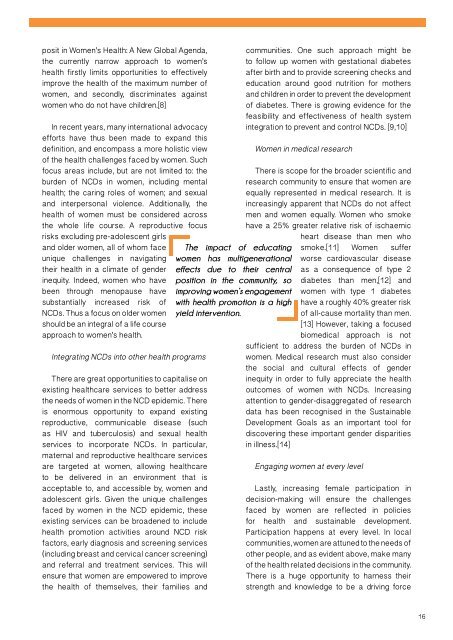Vector Volume 11 Issue 1 - 2017
Create successful ePaper yourself
Turn your PDF publications into a flip-book with our unique Google optimized e-Paper software.
posit in Women’s Health: A New Global Agenda,<br />
the currently narrow approach to women’s<br />
health firstly limits opportunities to effectively<br />
improve the health of the maximum number of<br />
women, and secondly, discriminates against<br />
women who do not have children.[8]<br />
In recent years, many international advocacy<br />
efforts have thus been made to expand this<br />
definition, and encompass a more holistic view<br />
of the health challenges faced by women. Such<br />
focus areas include, but are not limited to: the<br />
burden of NCDs in women, including mental<br />
health; the caring roles of women; and sexual<br />
and interpersonal violence. Additionally, the<br />
health of women must be considered across<br />
the whole life course. A reproductive focus<br />
risks excluding pre-adolescent girls<br />
and older women, all of whom face<br />
unique challenges in navigating<br />
their health in a climate of gender<br />
inequity. Indeed, women who have<br />
been through menopause have<br />
substantially increased risk of<br />
NCDs. Thus a focus on older women<br />
should be an integral of a life course<br />
approach to women’s health.<br />
Integrating NCDs into other health programs<br />
There are great opportunities to capitalise on<br />
existing healthcare services to better address<br />
the needs of women in the NCD epidemic. There<br />
is enormous opportunity to expand existing<br />
reproductive, communicable disease (such<br />
as HIV and tuberculosis) and sexual health<br />
services to incorporate NCDs. In particular,<br />
maternal and reproductive healthcare services<br />
are targeted at women, allowing healthcare<br />
to be delivered in an environment that is<br />
acceptable to, and accessible by, women and<br />
adolescent girls. Given the unique challenges<br />
faced by women in the NCD epidemic, these<br />
existing services can be broadened to include<br />
health promotion activities around NCD risk<br />
factors, early diagnosis and screening services<br />
(including breast and cervical cancer screening)<br />
and referral and treatment services. This will<br />
ensure that women are empowered to improve<br />
the health of themselves, their families and<br />
The impact of educating<br />
women has multigenerational<br />
effects due to their central<br />
position in the community, so<br />
improving women’s engagement<br />
with health promotion is a high<br />
yield intervention.<br />
communities. One such approach might be<br />
to follow up women with gestational diabetes<br />
after birth and to provide screening checks and<br />
education around good nutrition for mothers<br />
and children in order to prevent the development<br />
of diabetes. There is growing evidence for the<br />
feasibility and effectiveness of health system<br />
integration to prevent and control NCDs. [9,10]<br />
Women in medical research<br />
There is scope for the broader scientific and<br />
research community to ensure that women are<br />
equally represented in medical research. It is<br />
increasingly apparent that NCDs do not affect<br />
men and women equally. Women who smoke<br />
have a 25% greater relative risk of ischaemic<br />
heart disease than men who<br />
smoke.[<strong>11</strong>] Women suffer<br />
worse cardiovascular disease<br />
as a consequence of type 2<br />
diabetes than men,[12] and<br />
women with type 1 diabetes<br />
have a roughly 40% greater risk<br />
of all-cause mortality than men.<br />
[13] However, taking a focused<br />
biomedical approach is not<br />
sufficient to address the burden of NCDs in<br />
women. Medical research must also consider<br />
the social and cultural effects of gender<br />
inequity in order to fully appreciate the health<br />
outcomes of women with NCDs. Increasing<br />
attention to gender-disaggregated of research<br />
data has been recognised in the Sustainable<br />
Development Goals as an important tool for<br />
discovering these important gender disparities<br />
in illness.[14]<br />
Engaging women at every level<br />
Lastly, increasing female participation in<br />
decision-making will ensure the challenges<br />
faced by women are reflected in policies<br />
for health and sustainable development.<br />
Participation happens at every level. In local<br />
communities, women are attuned to the needs of<br />
other people, and as evident above, make many<br />
of the health related decisions in the community.<br />
There is a huge opportunity to harness their<br />
strength and knowledge to be a driving force<br />
16

















